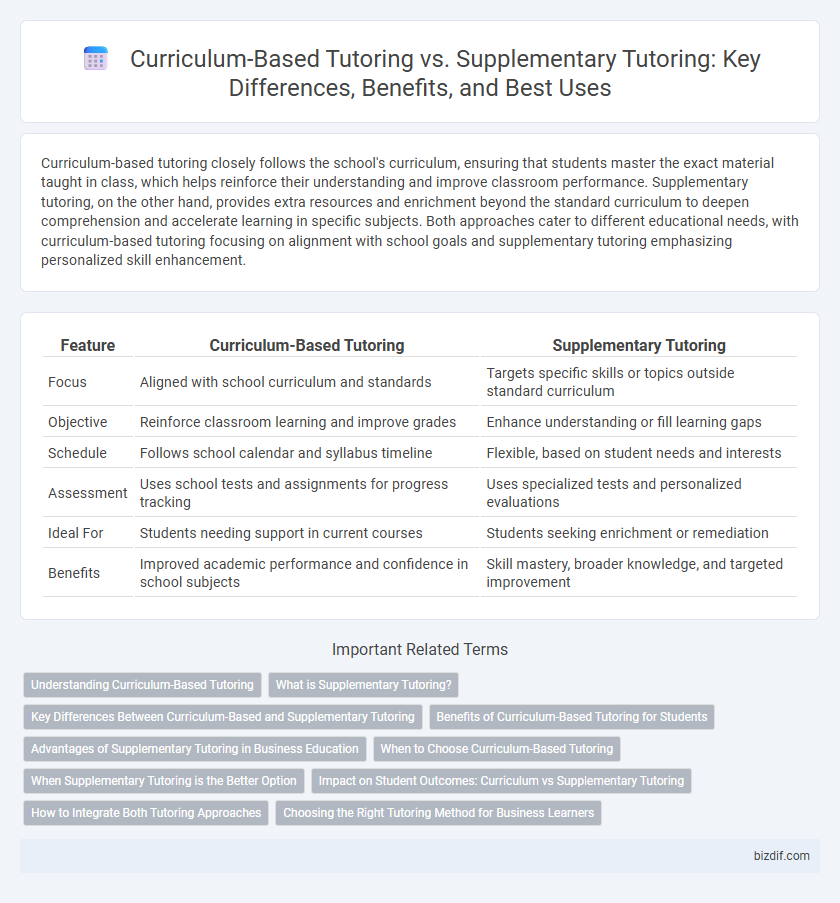Curriculum-based tutoring closely follows the school's curriculum, ensuring that students master the exact material taught in class, which helps reinforce their understanding and improve classroom performance. Supplementary tutoring, on the other hand, provides extra resources and enrichment beyond the standard curriculum to deepen comprehension and accelerate learning in specific subjects. Both approaches cater to different educational needs, with curriculum-based tutoring focusing on alignment with school goals and supplementary tutoring emphasizing personalized skill enhancement.
Table of Comparison
| Feature | Curriculum-Based Tutoring | Supplementary Tutoring |
|---|---|---|
| Focus | Aligned with school curriculum and standards | Targets specific skills or topics outside standard curriculum |
| Objective | Reinforce classroom learning and improve grades | Enhance understanding or fill learning gaps |
| Schedule | Follows school calendar and syllabus timeline | Flexible, based on student needs and interests |
| Assessment | Uses school tests and assignments for progress tracking | Uses specialized tests and personalized evaluations |
| Ideal For | Students needing support in current courses | Students seeking enrichment or remediation |
| Benefits | Improved academic performance and confidence in school subjects | Skill mastery, broader knowledge, and targeted improvement |
Understanding Curriculum-Based Tutoring
Curriculum-Based Tutoring aligns directly with school syllabi, emphasizing mastery of the exact material students encounter in class to enhance their academic performance and test readiness. This approach uses tailored lessons and assessments mirroring classroom instruction, ensuring consistency and reinforcing learning objectives. Understanding Curriculum-Based Tutoring is crucial for parents and educators aiming to improve knowledge retention and close learning gaps by synchronizing tutoring content with school curricula.
What is Supplementary Tutoring?
Supplementary tutoring provides additional academic support beyond the standard curriculum to reinforce learning, target specific skill gaps, and enhance understanding in particular subjects. It complements classroom instruction by focusing on personalized strategies, exam preparation, and homework assistance tailored to the student's needs. Unlike curriculum-based tutoring, which strictly follows school syllabi, supplementary tutoring offers flexible content that adapts to individual learning goals and challenges.
Key Differences Between Curriculum-Based and Supplementary Tutoring
Curriculum-based tutoring aligns directly with classroom objectives, focusing on mastering specific school subjects and adhering to standardized curricula essential for grade-level success. Supplementary tutoring offers personalized support beyond the standard curriculum, targeting skill gaps, enrichment opportunities, and test preparation to enhance overall academic performance. The primary difference lies in curriculum-based tutoring's structured approach to school syllabi, while supplementary tutoring adapts to individual learning needs and goals outside regular coursework.
Benefits of Curriculum-Based Tutoring for Students
Curriculum-based tutoring aligns directly with classroom standards, ensuring personalized support that reinforces core academic concepts and boosts subject mastery. This targeted approach enhances students' confidence and promotes consistent academic progress by addressing specific gaps within the school curriculum. Research shows curriculum-based tutoring significantly improves standardized test scores and overall academic achievement compared to supplementary tutoring methods.
Advantages of Supplementary Tutoring in Business Education
Supplementary tutoring in business education offers personalized learning that targets specific skill gaps beyond the standard curriculum, enhancing practical knowledge in areas like finance, marketing, and management. It provides flexibility in pacing and topic selection, allowing students to deepen their understanding of complex business concepts and real-world applications. By focusing on individualized needs, supplementary tutoring improves critical thinking and problem-solving abilities, essential for success in competitive business environments.
When to Choose Curriculum-Based Tutoring
Curriculum-Based Tutoring is ideal for students who need targeted support aligned with their school's syllabus to improve performance in regular assessments and standardized tests. It ensures mastery of grade-specific concepts and skills, providing systematic progression through core subjects like math, reading, and science. Selecting this approach benefits learners requiring structured reinforcement to close gaps in foundational knowledge and boost academic confidence within the school curriculum framework.
When Supplementary Tutoring is the Better Option
Supplementary tutoring is the better option when students require targeted support to reinforce classroom learning or address specific weaknesses without replacing the entire curriculum. It effectively complements school instruction by focusing on challenging subjects or exam preparation, providing personalized attention to improve understanding and performance. This approach benefits learners balancing a full academic schedule while aiming to boost grades or mastery in select areas.
Impact on Student Outcomes: Curriculum vs Supplementary Tutoring
Curriculum-based tutoring directly aligns with school standards and classroom instruction, leading to improved mastery of core subjects and higher standardized test scores. Supplementary tutoring offers targeted support for specific skill gaps or enrichment, enhancing student confidence and motivation without replacing core curriculum learning. Research shows curriculum-based tutoring has a stronger impact on overall academic achievement, while supplementary tutoring effectively boosts performance in particular areas.
How to Integrate Both Tutoring Approaches
Integrating curriculum-based tutoring with supplementary tutoring enhances personalized learning by aligning additional support directly with classroom objectives while addressing individual skill gaps. Effective integration involves coordinating curriculum goals with customized enrichment activities that reinforce core concepts and promote skill mastery. Consistent communication between tutors, students, and educators ensures that both approaches complement each other, maximizing academic growth and retention.
Choosing the Right Tutoring Method for Business Learners
Curriculum-based tutoring aligns directly with formal academic programs, ensuring business learners master essential course content and achieve measurable progress within their structured studies. Supplementary tutoring provides targeted skill enhancement and practical applications beyond the standard curriculum, addressing specific business challenges or professional development goals. Selecting the right tutoring method depends on the learner's objectives, where curriculum-based tutoring suits exam preparation and foundational knowledge, while supplementary tutoring benefits skill specialization and real-world business problem solving.
Curriculum-Based Tutoring vs Supplementary Tutoring Infographic

 bizdif.com
bizdif.com